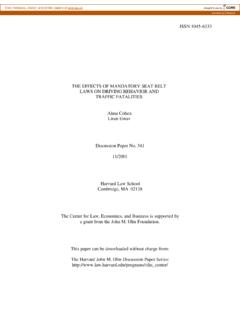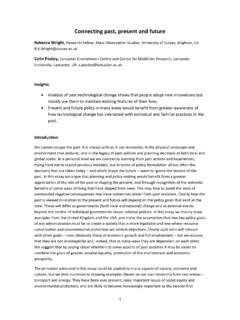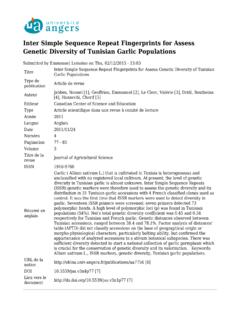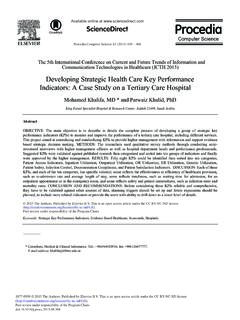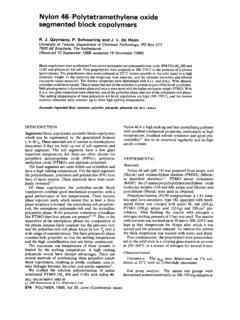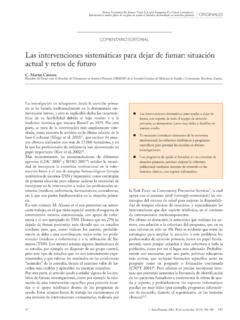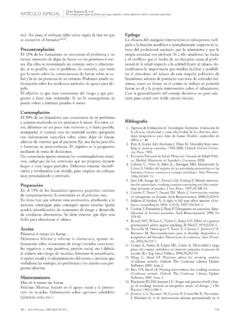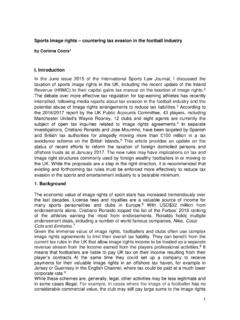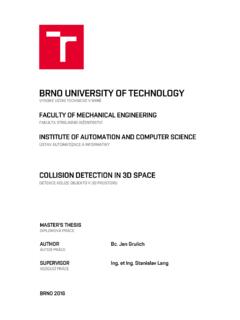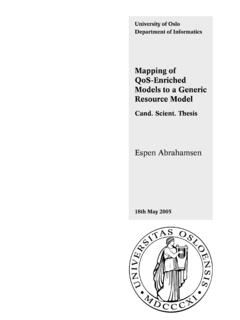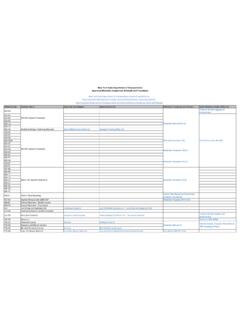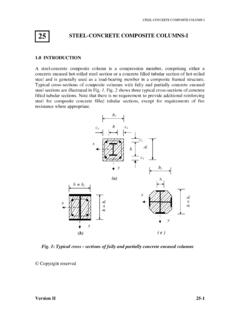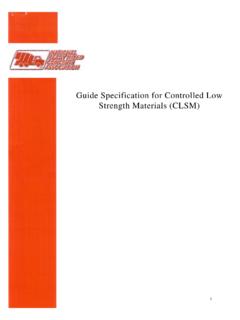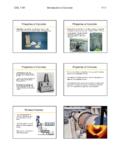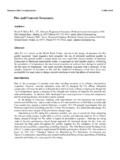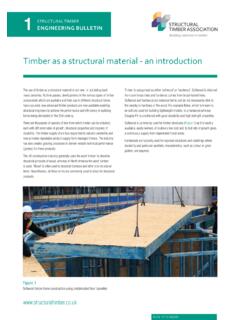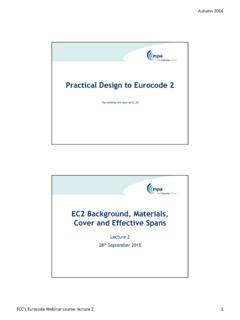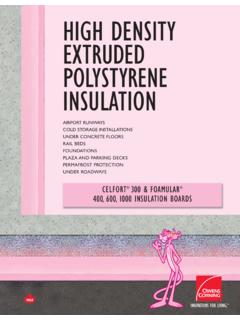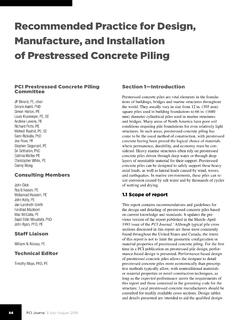Transcription of STUDY OF LIGHTWEIGHT CONCRETE BEHAVIOUR
1 1 STUDY OF LIGHTWEIGHT CONCRETE BEHAVIOUR LIGHTWEIGHT CONCRETE can be defined as a type of CONCRETE which includes an expanding agent in that it increases the volume of the mixture while giving additional qualities such as nailbility and lessened the dead weight. It is lighter than the conventional CONCRETE . The use of LIGHTWEIGHT CONCRETE has been widely spread across countries such as USA, United Kingdom and Sweden. The main specialties of LIGHTWEIGHT CONCRETE are its low density and thermal conductivity. Its advantages are that there is a reduction of dead load, faster building rates in construction and lower haulage and handling costs. LIGHTWEIGHT CONCRETE maintains its large voids and not forming laitance layers or cement films when placed on the wall.
2 This research was based on the performance of aerated LIGHTWEIGHT CONCRETE . However, sufficient water cement ratio is vital to produce adequate cohesion between cement and water. Insufficient water can cause lack of cohesion between particles, thus loss in strength of CONCRETE . Likewise too much water can cause cement to run off aggreagate to form laitance layers, subsequently weakens in strength . Therefore, this fundamental research report is prepared to show activities and progress of the LIGHTWEIGHT CONCRETE . Focused were on the performance of aerated LIGHTWEIGHT CONCRETE such as compressive strength tests, water absorption and density and supplementary tests and comparisons made with other types of LIGHTWEIGHT CONCRETE .
3 Key researchers: Hjh Kamsiah (Head) Mohamad Shazli Fathi Norpadzlihatun bte Manaf E-mail : Tel No : 03-26154397 Vot No : 71908 brought to you by COREView metadata, citation and similar papers at by Universiti Teknologi Malaysia Institutional Repository iiKAJIAN TERHADAP KELAKUAN KONKRIT RINGAN Konkrit ringan ditakrifkan sebagai konkrit yang dicampur demean agen pengembang di mana pertambahan isipadu campuran berlaku dan memberi kualiti tambah bahan seperti pengikatan kuat dan ringan antara zarah-zarah simen dan batu baur. Konkrit ini adalah ringan dari konkrit biasa dan penggunaannya berleluasa di Negara-negara Amerika, United Kingdom and Sweden. Ciri utama konkrit ringan ini ialah ketumpatan dan pengaliran haba yang rendah.
4 Kebaikan bahan di mana pengurangan berat bahan amat ketara, justru pembinaan lebih mudah dan seterusnya pengurangan perbelanjaan dari segi pengangkutan untuk pembinaan. Konkrit ringan mengekalkan liang dan tidak mengakibatkan pembentukan lapisan laitance layers atau filem simen apabila di pasang di dinding. Penyelidikan ini berasaskan kelakuan konkrit ringan berliang udara. Walaubagaimanapun, nisbah air simen mencukupi penting untuk menghasilkan lekatan antara simen dan air yang baik. Kekurangan air boleh menyebabkan ikatan di antara zarah-zarah lemah, justru hilang kekuatan konkrit tersebut. Begitu juga sebaliknya, jika nisbah air tinggi akan menyebabkan simen tidak dapat mengikat batu-baur sepenuhnya untuk pembentukan lapisan laitance seterusnya melemahkan kekuatan konkrit.
5 Oleh yang demikian, laporan penyelidikan asas ini hanya menunjukkan aktiviti dan progres dalam pembentukan konkrit ringan. Kelakuan konkrit ringan seperti kekuatan mampatan, penyerapan air, ketumpatan dan ujian tambahan telah dijalankan dan perbandingan telah dibuat dengan bahan binaan konkrit ringan lain. Penyelidik: Hjh Kamsiah (Ketua) Mohamad Shazli Fathi Norpadzlihatun bte Manaf E-mail : Tel No : 03-26154397 Vot No : 71908 CONTENTS ABSTRACT I CHAPTER 1 : INTRODUCTION 1 Preface 1 Research activity 1 CHAPTER 2.
6 LITERATURE REVIEW OF LIGHTWEIGHT CONCRETE Introduction 3 Types of LIGHTWEIGHT CONCRETE 4 Advantages and disadvantages of LIGHTWEIGHT CONCRETE 8 Application of LIGHTWEIGHT CONCRETE 9 CHAPTER 3 : METHODOLOGY Testing program of LIGHTWEIGHT CONCRETE 10 Compressive strength 10 Water absorption 11 Density 11 CHAPTER 4 : RESULTS AND DISCUSSIONS Introduction 12 strength and density comparison 12 Compressive strength 13 Water absorption 15 Supplementary test 16 CHAPTER 5.
7 CONCLUSION Conclusion 26 REFERENCES 27 APPENDIXES 28 v DIAGRAMS CHAPTER 2 : LITERATURE REVIEW OF LIGHTWEIGHT CONCRETE Figure 1 The Pantheon Figure 2 No-fines CONCRETE Figure 3 LIGHTWEIGHT Aggregate CONCRETE Figure 4 Aerated CONCRETE CHAPTER 4 : RESULTS AND DISCUSSIONS Figure 1 Compressive strength at Different Density of Hardened CONCRETE Figure 2 Compressive strength at Different Percentage of Foam Figure 3 Compressive strength at Different Foam & water ratio Figure 4 Compressive strength at Different Cement and Sand ratio Figure 5 Compressive strength at Different Cement and Water ratio Figure 6 Water absorption at different percentage of foam Figure 7 Water absorption at different foam agent and water ratio Figure 8 Moisture content at different percentage of foam Figure 9 Density of wet and hardened CONCRETE vi TABLES CHAPTER 2.
8 LITERATURE REVIEW OF LIGHTWEIGHT CONCRETE Table 1 Types and Grading of LIGHTWEIGHT CONCRETE Table 2 Advantages and disadvantages of LIGHTWEIGHT CONCRETE CHAPTER 4 : RESULTS AND DISCUSSIONS Table 1 Density of hardened CONCRETE and compressive strength at 28 days. Table 2 Compressive strength for different percentage of foam Table 3 Compressive strength at different foam agent and water ratio Table 4 Compressive strength at different cement and sand ratio Table 5 Compressive strength at different cement and water ratio Table 6 Water absorption at different percentage of foam Table 7 Water absorption at different foam agent and water ratio Table 8 Moisture content at different percentage of foam Table 9 Density of hardened and wet CONCRETE at different percentage of foam.
9 Table 10 Properties of LIGHTWEIGHT CONCRETE 1 CHAPTER 1 : INTRODUCTION PREFACE LIGHTWEIGHT CONCRETE can be defined as a type of CONCRETE which includes an expanding agent in that it increases the volume of the mixture while giving additional qualities such as nailbility and lessened the dead weight. LIGHTWEIGHT CONCRETE maintains its large voids and not forming laitance layers or cement films when placed on the wall. This research was based on the performance of aerated LIGHTWEIGHT CONCRETE . However, sufficient water cement ratio is vital to produce adequate cohesion between cement and water. Insufficient water can cause lack of cohesion between particles, thus loss in strength of CONCRETE .
10 Likewise too much water can cause cement to run off aggreagate to form laitance layers, subsequently weakens in strength . This research report is prepared to show the activities and progress of the LIGHTWEIGHT CONCRETE research project. The performance of aerated LIGHTWEIGHT CONCRETE such as compressive strength tests, water absorption and density and supplementary tests and comparisons made with other types of LIGHTWEIGHT CONCRETE were carried out. Research activity OPERATIONAL PLAN No. TASK YEAR 2002 YEAR 2003 YEAR 2004 Q1 Q2 Q3 Q4 Q1 Q2 Q3 Q4 Q1 Q2 Q3 Q4 1 LITERATURE REVIEW 2 TAKING SAMPLES, PREPARATION (MANUFACTURE) 3 TESTING AND DATA COLLECTION 24 ANALYSIS 5 PRODUCT FORMULATION 6 REPORT WRITING Technology transfer Activities.
